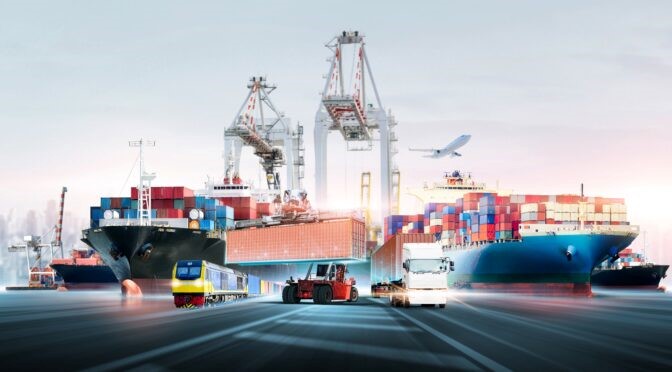With many companies still recovering from the fallout of pandemic-induced supply chain disruptions, the increasingly turbulent global trade landscape—rife with geopolitical conflict, environmental disasters, and escalating trade wars—places a heavy burden on logistics and supply chain operations. While most businesses understand that building resiliency and responsiveness into global supply chains is imperative in light of the current administration’s neomercantilist policies and growing global trade uncertainty, keeping goods flowing while protecting margins can be a formidable challenge for logistics and supply chain leaders in 2025.
Read also: Global Trade Forecast to Expand Amid U.S. Tariff Policies
De minimis on the chopping block
Given the ecommerce explosion in recent years, many U.S. consumers and ecommerce retailers rely on the de minimis exception to import low-cost packages (i.e., goods valued below US$800) without paying duties. According to U.S. Customs and Border Protection (CBP), de minimis shipments account for 92% of all cargo entering the U.S., representing more than 1 billion small-value packages arriving annually. To put this in perspective, on any given day, cargo operations at JFK Airport could receive and process between 750,000 and 1 million de minimis shipments.
In an abrupt policy decision on February 4th, the administration cancelled the de minimis exception—meaning low-value packages arriving from China, Mexico and Canada were required to undergo the formal entry process requiring additional documentation and payment of duties—only to pause the repeal two days later in response to chaotic disruptions for airports, customs operations, postal and delivery services, ecommerce retailers and consumers.
But with the government working to implement “adequate systems…to fully and expediently process and collect tariff revenue” and an official update expected on April 1st, businesses involved in cross-border commerce must take steps to prepare for the suspension of the de minimis regulation by evaluating the potential impact on operational costs, product sourcing decisions, and the customer experience.
Chaotic tariff landscape
The escalating U.S. trade war continues to be a rollercoaster ride not for the faint of heart. The U.S. has imposed—and, in some cases, subsequently walked back or paused—a sweeping range of tariffs, including 20% on all China imports, 25% on most goods from Canada and Mexico, and a worldwide 25% on steel and aluminum. The administration’s “stop-start” approach to tariffs, along with shifting trade policies, rapidly evolving compliance regulations, and the impact of real and potential retaliatory tariffs, has left many businesses in limbo, pondering the best course of action moving forward.
Should they pass the tariff increases on to their customers and brace for pushback, or can they afford to absorb the cost and still protect margins? Perhaps renegotiating supplier contracts or identifying alternate suppliers is the best tactic for navigating the turbulent trade environment. Or should they consider near-sourcing or taking advantage of foreign trade zones (FTZs)? The bottom line is, as the trade war heats up and cross-border commerce becomes increasingly complex and fractious, logistics and supply chain leaders need strategic long-term solutions to reduce the risk and mitigate the impact of higher costs and supply chain disruptions.
FTZ: Island in the storm?
The cost-saving and duty-optimizing benefits of FTZs—secure areas, such as large warehouses or industrial parks, authorized by the federal government in which goods are treated as if they are outside of U.S. Customs territory for duty purposes—can help some companies navigating a volatile global trade landscape. By taking advantage of FTZs, companies can lessen the immediate effect of tariffs (excluding imports subject to Section 301 tariffs) by deferring customs duties and federal excise tax on imports until they leave the zone and enter U.S. Customs territory. Plus, duties are eliminated on imports that are later re-exported and on goods considered waste, scrap, or defective—a distinct cost benefit for businesses importing fragile items or employing manufacturing processes that produce large amounts of scrap.
Integrating FTZs into their supply chain enables businesses to take advantage of lower insurance premiums, reduce merchandise processing fees (MPFs), and streamline logistics and inventory management. Companies can also reap cost savings through inverted tariffs that give companies the option of paying duty on a finished product or on the individual components, whichever is lower. While not a panacea for tariff wars and rapidly evolving trade regulations, FTZs can help mitigate the risks posed by this volatility.
Shoring up the supply chain
In addition to (where feasible) leveraging trade instruments such as FTZs and Free Trade Agreements, importers need to focus on building resilience and responsiveness into their supply chains—and evaluating supplier relationships is part of this process. For existing suppliers and distribution partners, businesses may elect to renegotiate contracts to include tariff cost-sharing mechanisms or provisions for tariff-triggered price renegotiations.
By modelling the impacts of increased tariffs on imported goods, companies can determine whether a change in sourcing strategy could offset potentially higher costs. Similarly, by evaluating supplier and factory location density, businesses can mitigate reliance on over-taxed trade lanes and prioritize trading partners in more stable regions with less potential for disruption.
Indeed, as trade tensions intensify, many companies are looking to diversify supplier and customer relationships and identify alternative trade lanes to limit risk exposure. According to a 2024 Descartes surveyglobal supply chain leaders feel that leveraging global trade intelligence to rapidly identify new suppliers, markets, and customers is the leading technology capability required to deliver the greatest business value in the next two years.
With the ever-present threat of new or increasing tariffs and regulatory changes, geopolitical instability, and supply chain disruptions, businesses need to explore the breadth of risk-mitigation strategies, on-the-ground tactics, and purpose-built technologies to help limit bottom-line exposure, ensure reliable customs compliance, and build a resilient and responsive supply chain moving forward.

